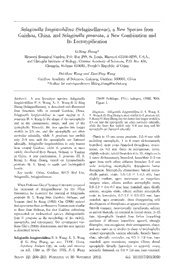
Selaginella longistrobilina (Selaginellaceae), a New Species from Guizhou, China, and Selaginella prostrata , a New Combination and Its Lectotypification PDF
Preview Selaginella longistrobilina (Selaginellaceae), a New Species from Guizhou, China, and Selaginella prostrata , a New Combination and Its Lectotypification
New Selaginella longistrobilina (Selaginellaceae), a Species from New Guizhou, China, and Selaginella prostrata a Combination and , Lectotypification Its 262 Novon P.^Wang crevices"on 1500 m, 24 June 1978, 75550 hill, Wang (PYU, Herbarium Pei-Shan [Guizhou Institute of Biology]). IUCN Red List category. Only two populations of Selaginella longistrobilina were observed the type at Selaginella prostrata (H. Kung) Li Bing Zhang, S. 20 locality, with fewer than individuals in total found. comb. nov. Basionym: Lycopodioides prostrata The new species might occur elsewhere in a nearby 7- H. Kung, Sichuan. S. LI. 6: 76, pi. 20, parts: similar habitat. Based on the best evidence available, & 11. 1988. [Latin diagnosis description in taxon can be Endangered this classified as Critically TYPE. Kung, Acta Yunnan. 254. Bot. 3: 1981.] IUCN Red (CR) according (IUCN, to List criteria Emei China. Sichuan: Shan, Jiushijiudaoguai, 2008). Shouxingqiao, 4 July 1955, Zheng 30071 X.-J. SZ (lectotype, designated here, PE; isolectotype, The new Etymology. epithet of the species is taken from the Latin prefix, “longi-,” meaning and meaning “long,” the Latin “strobilina,” “of the When Kung Discussion. (1981: 254) described which strobilus,” refers to the long strobili. he his Selaginella prostrata cited three gatherings: , NE Discussion. Selaginella longistrobilina has been X.-J. Zheng 30071 from Sichuan, Yunnan Exp. PYU (KUN confused with prostrata (H. Kung) Li Bing 808 not seen, PE, not seen) from Yunnan, S. S. Wang MO, PYU, Zhang and 75606 (CDBI, Herbarium (comb, nov.; see below) since the publication P.-S. Wang Pei-Shan [Guizhou from of the basionym of the Lycopodioides prostrata Institute of Biology]) latter, & Kung Wang Wang, H. (Kung, 1988; 2001). S. Chu name When type, as noted by (2006). Therefore, this describing a taxon identified as “prostrata” Kung name was not validly published by in 1981, following (Kung, 1981; the not validly published; see Kung the International Code of Botanical Nomenclature later discussion), (1981) cited three gatherings from Guizhou, Sichuan, and Yunnan, which included (McNeill et al., 2006, Art. 37.1). Kung made new Later, (1988: a combination, 76) “Lycopodioides prostrata (H. Kung) H. Kung,” correspond with Kung’s “prostrata” (Chu, 2006), S. S. name Kung based on 1981 his invalid in Selaginella. while the collection from Guizhou selected herein is (1988: implicated one of the three gatherings as the type of the newly described longistrobilina. 76) S. Kung Zheng 30071 cited in (1981) as the type, X.-J. Both taxa are indeed similar each other in the to from Emei Shan in Sichuan, by stating that “the type shape of the microphylls and also share other was collected from Emei Shan” in Chinese. This type similarities in the arrangement, shape, and size of designation, together with Kung’s (1988: 76) refer- the sporophylls. However, the two taxa do differ in the ence to the previously and effectively published Latin morphology of their strobili, sporophylls, sculpturing description and diagnosis by him (Kung, 1981: 254), of spores, and colpi of microspores as noted by Chu Kung validated the publication of prostrata H. L. S. (2006). Selaginella longistrobilina often has strobili new (1988) as a species (McNeill et al., 2006: Art. new name 36.1) instead of a combination or the S. branching positions of ultimate branchlets upward. Kung prostrata H. Kung, which did not S. (1988) The and larger sporophylls are adaxial clearly intend publish. Article 37.7 does not apply, since to navicular. Microspores have verrucate sculpturing was by the specific deposit of the type not required with irregularly sized verrucae; the colpi of micro- the Code until 1990. The herbarium of deposit for the and spores are twisted, usually not forked the ends, at Kung was by type of prostrata not indicated L. (1988). they reach the equatorial plane of the spore. known Zheng There are two specimens to us for X.-J. Irregularly verrucate sculpturing of the microspores PE 30071, which are deposited and SZ, and herein at common among species of Selaginella P. Beauv. In is We PE we specimen designate the as lectotype. at 3-4 contrast, S. prostrata has shorter strobili, to only PE were able to confirm the taxonomic identity of the mm, and the sporophylls are located only the at sheet, but did not see the SZ specimen, and thus the known PE specimen better chosen. is flattened adaxially, with only a few of the upper, We adaxial sporophylls slightly navicular. The micro- Acknowledgments. thank Wei-Ming Chu of spores are tuberculate with regularly sized tuber- cules; the microspore colpi are straight, forked at the rizing the differences between Selaginella long- We ends, and do not extend to the equatorial plane. istrobilina and S. prostrata. thank Faqiang Lii
